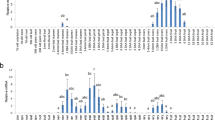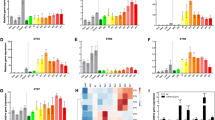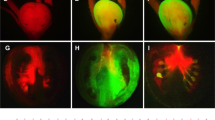Abstract
Transgenic tomato plants expressing antisense RNA to a ripening related gene (pTOM5) have yellow ripening fruit and pale colored flowers. The yellow fruit color is correlated with a severe reduction in the level of the pTOMS gene mRNA during fruit ripening. The level of carotenoids in ripening fruit from selected transgenic plants showing yellow fruit was reduced by more than 97 percent. In addition, the carotenoid lycopene, which is primarily responsible for the red color of ripening fruit, was reduced to undetectable levels (<0.1%). These data indicate that the pTOM5 gene is crucial to tomato fruit carotenoid biosynthesis.
This is a preview of subscription content, access via your institution
Access options
Subscribe to this journal
Receive 12 print issues and online access
$209.00 per year
only $17.42 per issue
Buy this article
- Purchase on Springer Link
- Instant access to full article PDF
Prices may be subject to local taxes which are calculated during checkout
Similar content being viewed by others
References
van der Krol, A.R., Lenting, P.E., Veenstra, J., van der Meer, I.M., Koes, R.E., Gerats, A.G.M., Mol, J.N.M. and Stuitje, A.R. 1988. An antisense chalcone synthase gene in transgenic plants inhibits flower pigmentation. Nature 333: 866–869.
Smith, C.J.S., Watson, C.F., Ray, J., Bird, C.R., Morris, P.C., Schuch, W. and Grierson, D. 1988. Antisense RNA inhibition of polygalacturonase gene expression in transgenic tomatoes. Nature 334: 724–726.
Rodermel, S.R., Abbott, M.S. and Bogorad, L. 1988. Nuclear-organelle interactions: Nuclear antisense gene inhibits ribulose bisphosphate carboxylase enzyme levels in transformed tobacco plants. Cell 55: 673–681.
Sheehy, R.E., Kramer, M. and Hiatt, W.R. 1988. Reduction of polygalacturonase activity in tomato fruit by antisense RNA. Proc. Natl. Acad. Sci. USA 85: 8805–8809.
Stockhaus, J., Hofer, M., Renger, G., Westhoff, P., Wydrzynski, T. and Willmitzer, L. 1990. Anti-sense RNA efficiently inhibits formation of the 10 kd polypeptide of photosystem II in transgenic potato plants: analysis of the role of the 10 kd protein. EMBO J. 9: 3013–3021.
Hamilton, A.J., Lycett, G.W. and Grierson, D. 1990. Antisense gene that inhibits synthesis of the hormone ethylene in transgenic plants. Nature 346: 284–287.
Smith, C.J.S., Watson, C.F., Morris, P.C., Bird, C.R., Seymour, G.B., Gray, J.E., Arnold, C., Tucker, G.A., Schuch, W., Harding, S. and Grierson, D. 1990. Inheritance and effect on ripening of antisense polygalacturonase genes in transgenic tomatoes. Plant Mol. Biol. 14: 369–379.
Slater, A., Maunders, M.J., Edwards, K., Schuch, W. and Grierson, D. 1985. Isolation and characterisation of cDNA clones for tomato polygalacturonase and other ripening-related proteins. Plant. Mol. Biol. 5: 137–147.
Mansson, P.-E., Hsu, D. and Stalker, D. 1985. Characterisation of fruit specific cDNAs from tomato. Mol. Gen. Genet. 200: 356–361.
Lincoln, J.E., Cordes, S., Read, E. and Fischer, R.L. 1987. Regulation of gene expression by ethylene during Lycopersicm esculentum fruit development. Proc. Natl. Acad. Sci. USA 84: 2793–2797.
Ray, J., Bird, C.R., Maunders, M., Grierson, D. and Schuch, W. 1987. Sequence of pTOM5, a ripening related cDNA from tomato. Nucl. Acids Res. 24: 10587.
Maunders, M.J., Holdsworth, M.J., Slater, A., Knapp, J., Bird, C.R., Schuch, W. and Grierson, D. 1987. Ethylene stimulates the accumulation of ripening-related mRNAs in tomatoes. Plant, Cell Environ. 10: 177–184.
Armstrong, G.A., Alberti, M. and Hearst, J.E. 1990. Conserved enzymes mediate the early reactions of carotenoid biosynthesis in nonphotosynthetic and photosynthetic prokaryotes. Proc. Natl. Acad. Sci. USA. 87: 9975–9979.
Bird, C.R., Smith, C.J.S., Ray, J.A., Moureau, P., Sevan, M.W., Bird, A.S., Hughes, S., Morris, P.C., Grierson, D. and Schuch, W. 1988. The tomato polygalacturonase gene and ripening-specific expression in transgenic plants. Plant Mol. Biol. 11: 651–662.
Porter, J.W. and Lincoln, R.E. 1950. I. Lycopersicon selections containing a high content of carotenes and colorless polyenes. II. The mechanism of carotenoid biosynthesis. Arch. Biochem. 27: 390–403.
Knapp, J., Moureau, P., Schuch, W. and Grierson, D. 1989. Organisation and expression of polygalacturonase and other ripening related genes in Ailsa Craig ‘Neverripe’ and ‘Ripening inhibitor’ tomato mutants. Plant Mol. Biol. 12: 105–116.
Stevens, M.A. and Rick, C.M. 1989. Genetics and breeding, p. 35–109. In: The Tomato Crop. Atherton J. G. and Rudich J. J. (Eds.). Chapman and Hall, New York.
Armstrong, G.A., Alberti, M., Leach, F. and Hearst, J.E. 1989. Nucleotide sequence, organisation and Nature of the protein products of the carotenoid biosynthesis gene cluster of Rhodobacter capsulatus. Mol. Gen. Genet. 216: 254–268.
Dogbo, O., Laferriere, A., D'Harlingue, A. and Camara, B. 1988. Carotenoid biosynthesis: Isolation and characterization of a bifunctional enzyme catalyzing the synthesis of phytoene. Proc. Natl. Acad. Sci. USA. 85: 7054–7058.
Frecknall, E.A. and Pattenden, G. 1984. Carotenoid differences in isogenic lines of tomato fruit colour mutants. Phytochemistry. 23: 1707–1710.
Darby, L.A., Ritchie, D.B. and Taylor, I.B. 1978. Isogenic lines of the tomato ‘Ailsa Craig’. Ann. Rep. Glasshouse Crops Research Inst. 168–184.
Kinzer, S.M., Schwager, S.J. and Mutschler, M.A. 1990. Mapping of ripening-related or -specific cDNA clones of tomato. Theor. Appl. Genet. 79: 489–496.
Bevan, M.W. 1984. Agrobacterium vectors for plant transformation. Nucl. Acids Res. 12: 8711–8721.
Lichtenstein, C. and Draper, J. 1985. Genetic engineering of plants, p. 67–120. In: DNA Cloning, Vol II (Glover, M. D. (Ed.). IRL Press, Oxford).
Britton, G. 1985. General carotenoids methods. Methods Enzymol. 111: 113–149.
Lichtenthaler, H.K. and Wellburn, A.R. 1983. Determinations of total carotenoids and chlorophylls a and b of leaf extracts in different solvents. Biochem. Soc. Trans. 11: 591–592.
Davies, B.H. 1976. Carotenoids, p. 38–162. In: Chemistry and Biochemistry of Plant Pigments, Goodwin T. W. (Ed.). Academic Press, London and New York.
Author information
Authors and Affiliations
Rights and permissions
About this article
Cite this article
Bird, C., Ray, J., Fletcher, J. et al. Using Antisense RNA to Study Gene Function: Inhibition of Carotenoid Biosynthesis in Transgenic Tomatoes. Nat Biotechnol 9, 635–639 (1991). https://doi.org/10.1038/nbt0791-635
Received:
Accepted:
Issue Date:
DOI: https://doi.org/10.1038/nbt0791-635
This article is cited by
-
The metabolic changes that effect fruit quality during tomato fruit ripening
Molecular Horticulture (2022)
-
Skin colour, carotenogenesis and chlorophyll degradation mutant alleles: genetic orchestration behind the fruit colour variation in tomato
Plant Cell Reports (2021)
-
Overexpression of a basic helix–loop–helix transcription factor gene, SlbHLH22, promotes early flowering and accelerates fruit ripening in tomato (Solanum lycopersicum L.)
Planta (2019)
-
Identified trans-splicing of YELLOW-FRUITED TOMATO 2 encoding the PHYTOENE SYNTHASE 1 protein alters fruit color by map-based cloning, functional complementation and RACE
Plant Molecular Biology (2019)
-
Association of molecular markers derived from the BrCRISTO1 gene with prolycopene-enriched orange-colored leaves in Brassica rapa
Theoretical and Applied Genetics (2014)



